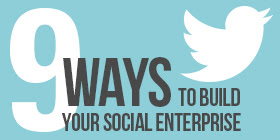
Let’s face it: Part of you – or maybe of all you – wonders how much of your organization’s valuable time and resources should be dedicated to social media. Consider the fact that in the fourth quarter of 2015, Facebook had 1.59 billion monthly active users in its social network. There are 500 million tweets on a given day according to Twitter. Numbers like these confirm that everything from how we process and consume information to how we engage with customers, prospects, partners – and everyone – has changed forever. Almost overnight, brands moved from one-to-one customer conversations to one to millions. People like your customers and prospects were at the center of this customer led revolution, and that is what makes social a game changer for business. No one knows your unique business better than you. And, that is exactly why you can’t copy someone else’s social enterprise blueprint. Your social strategy must account for the objectives that match your business goals. Everything begins with conveying what social media means to your business, your customers and your employees – and how everyone will benefit. The biggest game changer over the past five years and the next five years in business is how companies use social media. Either business gets social or it gets left behind.
Here are nine ways to build your own social enterprise.
1. Define Your Vision. Before we step forward, let’s take a step back. Think about how social media can improve customer and employee relationships. What do these relationships look like over the course of one, two or even three years? You must set the foundation for the vision. Remember that social channels are designed for two-way conversations; they are not just another marketing channel for broadcasting your message. It’s about empowering them, learning from them, and leading them. Challenge yourself to write something that makes your communities think, I’d like to do business with that company or that’s the type of hotel where I want to stay.
2. Set Clear Goals. Once you have articulated your vision, it is time to modify relevant processes as necessary and empower champions to lead the social transformation at every level. The continuing explosion of social media sites and technologies means the possibilities are virtually endless.
Consider starting small, on a few key social channels, and then adding to your enterprise as you spread your social wings. Do not lose sight that technology is not the end game. And, that social media – in and of its self – is not a strategy. Be sure your mission aligns with business priorities and objectives. Set milestones and checkpoints. It is important that you document your organization’s expectations and set clear goals.
3. Create Purpose. OnSocial media is a very personal and emotional landscape. If your vision is what you are striving for, and your mission is how you are getting there, then your purpose is why you are doing it all.
The next step is to give your colleagues a reason to believe. Why should they enlist? How will everyone win in the process? It’s time to pull together a trusted group of change agents. Each stakeholder will represent key functions to ensure that social transformation is thoughtful and operationalized.
4. Establish a Social Taskforce. Think about the people who will make your social transformations happen. Your taskforce should include people from across your organization who are savvy about social media and knowledgeable about your business and its goals. It should include all relevant lines of business and functions, including HR, legal, marketing, sales, food and beverage and customer service. This group will be responsible for establishing governance, best practices and policies that support cross-functional teams and business units. And they will ensure your social media objectives tie back to key business objectives.
5. Make Your Customer King. Today’s customer has more power than ever. It’s time to recognize and embrace the fact that, thanks to social technology, customers are now in the driver’s seat. Everyone knows that referrals from friends are far more valuable than messages from a company. The viral velocity of social networks have made referrals a way of life for consumers – do everything you can to encourage your customers to vote with their influence.
On the flip side, be aware that while social media can spread powerful endorsements at unprecedented speeds, mistakes can also be broadcast at the speed of social. Customers can air their complaints to thousands, or millions of people online in an instant. Keep in mind that these posts can last forever, and can pop up 24 hours a day, 7 days a week.
6. Get One View of Your Customer. You probably have basic contact information for your customers. Today, this information typically resides in your PMS, POS, sales and catering, CRS, and others. However, yesterday’s contact processes fail to take into account the new social touch points that are so important. It is important to connect the social Web to your customer databases to establish a single, holistic profile of your customer. Then you can engage with them in more meaningful ways, correct unforeseen mistakes, enhance the perception of your brand, and gather intelligence to improve your products and services.
7. Empower with Social Tools. Today’s social networks empower the individual like no other technology before. On public social networks, people are building personal brands and massive amounts of influence. Now the same thing is happening among employees inside of companies via enterprise social networks. Many companies make engaging customers a top priority, but fail to engage their own employees and turn them into brand representatives.
In this social economy, blocking employees from social networks is doing them – and your customers – a huge disservice. Embrace that your employees have aspirations and ambitions. They want to believe in your vision. Help them. Guide them. Empower them.
8. Tear Down Department Silos. In many organizations, social media operates solely in the silo of the marketing department. Quite frankly, customers don’t care about your departmental silos. They see a single company and they expect every department to act like they are connected. It’s critical that your social enterprise provides routes and resolution for all facets of your business.
For example, employees in your sales, guest services and accounting teams can collaborate in an employee social network and solve customer issues quickly. Or, marketing can use social tools to quickly respond to materials requests from your sales team.
9. Turn Weak Ties into Strong Connections. Because you all work at the same company, all your employees are tied loosely together by default. A social enterprise can make those weak lines become stronger connections and make the context around customer needs or business problems immediately apparent. The power of an enterprise social network is that an employee looking to get an answer from one colleague will often get a faster reply from another colleague, who they may not even know, but who saw the social interaction in passing. Enterprise collaboration is key.
A simple question about whether someone knows a CIO at another company you are selling might instead lead to a discovery that the company’s CEO is the brother of an employee.


 this; over the last 2 years, 90% of the world’s data has been created.
this; over the last 2 years, 90% of the world’s data has been created.